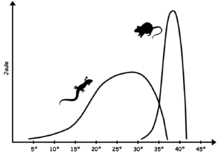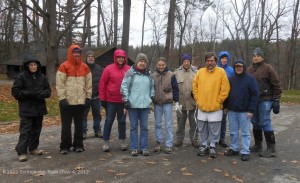Another winter has definitely come. The hardwood trees are bare and there’s much less animal life around. So, what kind of animals are active in the winter? From this list, beetles, frogs, snakes, blue jays, raccoons, which of these might we encounter on our winter hikes?
In order for the internal chemical reactions, that support animal activity, to take place, the animal must have an internal body temperature that’s high enough. At least, water, the solvent for these reactions, must be in the liquid state. To be active, most animals need to move to an environment that’s above 32F. You might have learned the term, cold blooded, for this type of internal temperature control. The proper zoological term is ectotherm – 
Sometime, in the evolution from reptiles, to birds and mammals, some, now extinct, intermediate animal, developed the ability to convert part of the food it ate, to internal body heat, and maintain a constant body temperature. The proper term is endothermic (endo-inside). All decendent birds and mammals have this ability.
Some fish can maintain sluggish activity in the cold water beneath the ice in a lake but, terrestrial ectothermic animals would die if exposed to sub freezing winter air temps so, to survive the winter, they must enter a state of dormancy in a sheltered spot. Insects, in different but specific life stages, amphibians, reptiles etc., all do this so, don’t expect to see active beetles, frogs or snakes, in the next few months, even though we saw a sluggish little frog, looking for a winter shelter, by Canadice Lake, last Sunday. An animal, that is endothermic, like us, can remain active in the winter, as long as it can conserve its body heat. So, on our hikes, we might hear a squawking blue jay or see a coon coming out at twilight (they’re nocturnal).

Sustained energy output of a warm-blooded (mammal) and a cold-blooded (reptile) animal as a function of core temperature
Endothermic has its advantages but does require a lot more food to generate this heat. Maybe, like Nat King Cole, you wish the lazy, hazy, crazy days of summer would always be here but, isn’t it nice, for the next few months, not to have to contend with mosquitoes or ticks?
Have you ever taken a good look at snowflake crystals? You don’t need any special equipment. Next time you see snow falling, put on a warm, dark jacket, go outside, catch falling snowflakes on your sleeve and look at them, and take the grandkids with you How many points are there on a snowflake crystal? Do they all have the same number of points? Are they all exactly alike?

